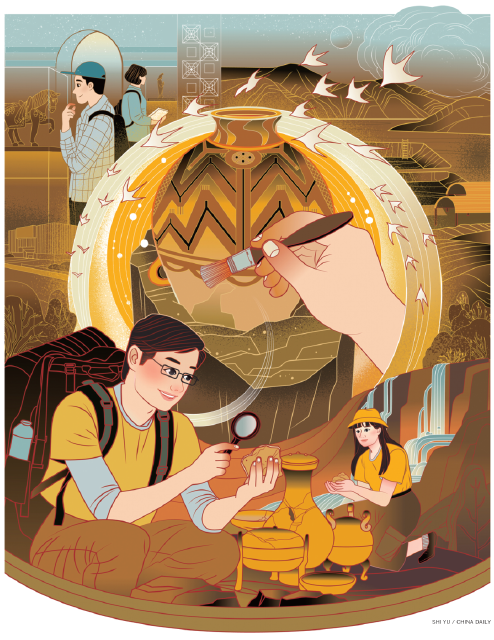Nurturing the future of archaeology
By WANG KAIHAO | China Daily | Updated: 2022-02-16 08:52

Multidisciplinary science requires multidisciplinary thinkers, program aims to fill gap in country's expertise
In 2021, there were 1,700 archaeological excavations in China, according to the National Cultural Heritage Administration.
Last year's big finds ranged from six new pits at the 3,000-year-old Sanxingdui site in Sichuan province to confirmation of the discovery of the mausoleum of Emperor Wen of Western Han Dynasty (220 BC-AD 24) in Shaanxi province.
These were probably the best gifts to mark the centenary of modern Chinese archaeology, which is traced back to the discovery of the 5,000-year-old Yangshao culture in Sanmenxia in present-day Henan province in 1921.
In a congratulatory letter to the ceremony to celebrate the anniversary in October, President Xi Jinping commended discoveries over the past century for demonstrating the depth of Chinese civilization, and called for developing an "archaeology with Chinese features, style and ethos that contributes to national rejuvenation".
In November, as part of cultural heritage work, archaeology featured in a national-level guidance for five-year development (2021-25) for the first time. The guidance also aims to create a group of top-class global academies of archaeology in China.
Despite inclusion in the national blueprint, the current shortfall of archaeologists presents a bottleneck.
For example, there are only about 1,000 archaeologists licensed to lead excavations and even counting everyone, there were only 6,000 qualified archaeologists in China last year.
"Most archaeologists face overwhelming schedules, and in some particularly demanding academic fields, that need extensive field experience and interdisciplinary expertise, the teams we have are not sufficient," said Song Xinchao, deputy director of the National Cultural Heritage Administration.
Consequently, a national program was launched by the administration in cooperation with the Ministry of Education in January. Top-tier universities and leading archaeological institutes will cooperate to nurture PhD candidates in academic fields where talent is most needed.
According to the plan, each university will select up to 10 PhD candidates for the program. They will be trained in interdisciplinary studies, using the resources of their schools and cooperating academies. The cost of the program will largely be supported by the central government.
Thirteen universities have been chosen for the program, including Peking University and Renmin University of China in Beijing, Fudan University in Shanghai, Nanjing University in Jiangsu province, and Wuhan University in Hubei province.
Partners include 16 leading research institutes like the Institute of Archaeology at the Chinese Academy of Social Sciences, the National Centre for Archaeology and the Palace Museum in Beijing, the Dunhuang Academy, which oversees Gansu province's Mogao Caves, and the Shaanxi Academy of Archaeology in Xi'an.
"It's a key step to nurturing top-class talent," He Yun'ao, an archaeology professor at Nanjing University, said. "Universities focus on academic research, but good researchers are not necessarily good field archaeologists. Institutes should offer much more practical opportunities."
He said that short-term programs were insufficient.
"A student may work on one site this year, and move somewhere else the next," he said. "But if we want to nurture the very best, we need to encourage them to become rooted in one specific field for longer periods."
"Through this new approach, a PhD candidate could develop broader horizons and become expert at solving issues from different perspectives," the professor continued.
Despite the many discoveries made by veteran scholars, He admitted that there are still shortcomings in Chinese archaeology and new generations are needed to fill in the gaps.
The new program has eight specific focuses, including grotto temples, underwater archaeology, frontier areas, and hi-tech approaches to natural sciences.
"These fields are urgently needed, but the orientation of PhD students is usually decided by their supervisor's focus, not by what is most needed," He explained. "The new policy will help students contribute to fields that may even be unfamiliar to their supervisors."
Tailored talent-development plans for each university and academy will be submitted to the Ministry of Education by the end of this month. Each participant in the program will be assigned as a leader in one or two specific fields among the eight, based on an evaluation of their respective academic advantages. Though students will continue to follow their original supervisors, resources from other institutions can be better shared through the new platform.
According to Liu Guoxiang, a researcher with the Institute of Archaeology at CASS, the program will promote exchanges between Chinese and foreign archaeologists, because overseas archaeology is among the eight fields of focus.
In 2018, the first Chinese field project began in Egypt since New China was founded in 1949. Dozens more projects, involving Chinese and foreign scholars, are underway in countries such as Honduras, Kenya, India, and along the former Silk Road.
"We need to evaluate Chinese civilization in its global perspective, and better understand how a civilization is born and grows, through comparative archaeology," Liu said. "We're a relatively late starter in overseas archaeology, but collaboration will help us enhance research capacity."
Both He and Liu emphasized the importance of archaeological theory in addition to fieldwork.
"Based on my 15-year experience of reviewing PhD dissertations, we get a handful papers on theory, while the vast majority focus on specific cases," He said.
However, the professor explained, modern archaeology now extends beyond humanities to a wide range of natural sciences and engineering.
"It's a complicated system, which requires comprehensive studies, while our current pedagogy tends to train archaeologists to focus on certain types of sites," He said. "But we also need versatile people to build up a new framework."
Liu added that a systematic archaeology theory with Chinese features will also contribute to global academic exchange.
"We've gathered lots of material over the past century, but we can't just apply foreign theories to what we've learned," Liu said. "We have to include our own thoughts and experiences to demonstrate the appeal of ancient Chinese civilization."
























